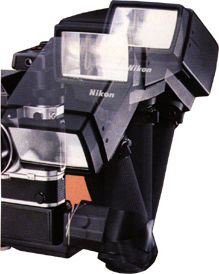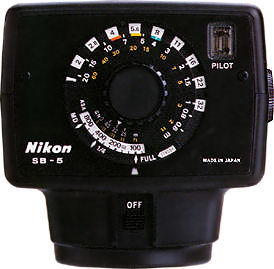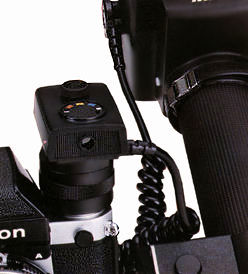
SB-5 Handle Mount Flash Unit
- This powerful electronic flash unit delivers an extra wide 67 degrees (Horizontal) x 48 degrees (Vertical) coverage. Enough to cover a 28mm wideangle lens. while this is standard and doesn't need an angle extension accessory and the guide number remains constant at 32 for ASA 100 film when the power is set at "FULL".
- Light Output Control:
- automatic: direct series control
with silicon controlled rectifier using optional sensor unit SU-1
manual: three output settings; full, 1/4, and 1/8 (MD) power - Guide Number:
- 32m (104ft) for ASA 100 film at
full power
- 16m (52ft) for ASA 100 film at 1/4 power
- 11m (36ft) for ASA 100 film at MD setting
- 16m (52ft) for ASA 100 film at 1/4 power
- Number of Flashes (appox.):
- 420 (SN-2, automatic, orange)
- 340 (SN-2, automatic, yellow)
- 230 (SN-2, automatic, blue)
- 3 000 (SD-4, automatic, orange)
- 2 200 (SD-4, automatic, yellow)
- 1 500 (SD-4, automatic, blue)
- 75 (SN-2, manual, full)
- 270 (SN-2, manual, 1/4)
- 400 (SN-2, manual, MD)
- 250 (SD-4, manual, full)
- 1 800 (SD-4, manual, 1/4)
- 4 000 (SD-4, manual, MD)
- 340 (SN-2, automatic, yellow)
- Recycling Time:
- <= 0.5 sec. (automatic, any
battery, at 2m)
- 2.6 sec. (SN-2, manual, full)
- 0.5 sec. (SN-2, manual, 1/4)
- 0.25 sec. (SN-2, manual, MD)
- 1.5 sec. (SD-4, manual, full)
- 0.4 sec. (SD-4, manual, 1/4)
- 0.25 sec. (SD-4, manual, MD)
- 2.6 sec. (SN-2, manual, full)
- Angle of Coverage:
- 67 deg. horizontal, 48 deg. vertical (speedlite positioned horizontally, 28mm field of view)
- Automatic f/ Numbers:
- Choice of three -- f/4, f/5.6, f/8 with ASA 100 film
- Automatic Shooting Range:
- 0.6-8m (2-26ft) at f/4 (orange)
- 0.6-5.6m (2-18ft) at f/5.6 (yellow)
- 0.6-4m (2-13ft) at f/8 (blue)
- 0.6-5.6m (2-18ft) at f/5.6 (yellow)
- Power Sources:
- rechargeable NiCd battery unit
SN-2
- battery pack SD-4 for laminated batteries
- Ready-light:
- provided
- Open Flash/Test Firing Button:
- provided
- Synch Socket for Eyepiece Pilot Lamp:
- provided
- Ready-light Contact for F2 Series Camera Finders:
- provided with accessory SC-4
- Bounce and Tilt:
- provided through rotating bracket, flash head
- Dimensions and Weight:
- 93 x 252 x 125mm ; 900g without
batteries
- 3.7 x 9.9 x 4.9 in. ; 31.7 oz. without batteries
- Accessories:
- ready-light adapter SC-4
- sync cord SC-5
- coiled sync cord SC-6
- sync cord SC-7
- extension cord SC-9
- extension cord SE-2
- flash unit coupler AS-2
- eyepiece pilot lamp SF-1
- sensor unit SU-1
- mounting bracket SK-3
- battery pack SD-4
- NC battery unit SN-2
- NC battery quick charger SH-2
- sync cord SC-5

The SB-5 is clearly a bridge between the relatively unsophisticated SB-1 (full-manual only) and the later SB-11 (TTL capable). It offers the next-best-thing: automatic flash control, using essentially the same unit mounted to the SB-2/3, along with the versatility and power of a side-mounted handle unit. In addition, it looks considerably more modern than the earlier SB-1, having the SB-11's general form but with the optional SU-1 sensor mounted on its right (camera) side. The SB-5's head may be rotated in 30 degree increments (in a plane perpendicular to the line of the handle) and/or the entire unit may be tilted at the junction with the SK-3 bracket, in order to accomplish bounce flash. It is clear that the SB-5 was designed for photojournalists and other photographers demanding a powerful, portable unit; no AC unit was ever offered for the SB-5. Incidentally, the Metz 45-series flashes (another PJ fave) are contemporaries of the SB-5 and are still being sold new. Although the 45-series doesn't have a detachable sensor (you have to buy a separate unit), they offer slightly better performance.
Flash attachment is similar to that of the SB-1, and standard sync is accomplished in the same way, via a PC-to-prong cord snaking from the camera to the bottom of the right (camera) side of the flash head. The main difference comes from the presence of the sensor SU-1, which may be mounted, via a circular socket, to either the side of the flash head, or to the camera body itself via the SC-9 cord, which has the circular plug (to go into the flash head) on one end and a F/F2-type foot on the other. This foot has the ready-light contact provided by the SC-4, as well as a circular socket on top to receive the SU-1.

Presumably, the SB-5 has a calculator dial on the back of the flash head, and a switch to change full-manual power to 1/4 or 1/8 (MD), as well as an on-off switch, ready light, and open flash button. The actual mode (manual, three automatic settings, and slave) is set via the SU-1; without it, the flash operates only in manual mode. Just like the SB-1, the appropriate NiCad battery (SN-2) slides into the handle of the SB-5 similar to hand torches. The optional high-voltage battery pack (SD-4) connects to a special connector in the same way as the SD-3 hooks into the side of the SB-1.
As befits a flash intended for
photojournalist duty, the SB-5 offers a "motor drive" (MD) power setting.
The flash will recycle in approximately 1/4th of a second at this setting; thus it
can keep up with the MD-2 set at a speed appropriate to the shutter sync speed. On
the other hand, at the time of the SB-5's introduction, most reporters were taking
the Vivitar 283 along with them, which offered many of the same advantages (including
automatic exposure) with even more power in a smaller package. With the appropriate
battery packs, the 283 offered similar recycling performance, making it nearly unbeatable
until the mid-eighties.
After having focussed on the subject in your viewfinder, note the distance to the
subject (from your lens's focus scale) and find the appropriate f-stop from the calculator
dial. You may use automatic flash as long as the distance you have focussed upon
(assuming that you want it lit by flash) is less than the maximum automatic distance
-- in this case, 8m (26ft) at the orange mark (if you want more depth of field, use
a differently colored mark but note that your maximum range decreases accordingly)).
Congratulations. You have now performed much of the function of a "D" lens,
which sends the exact same information to the SB-27. Alternatively, you may set the
f-stop to the one that lines up with the focussing distance, in manual mode. This
will ensure that everything up to the focussed subject will be properly (over) exposed;
the background is more a function of which shutter speed you set. For nicer results,
you may want to decrease the flash exposure by 1/3 to 5/3 of a stop (by rating the
film correspondingly faster), take a meter reading of the background, and use an
aperture-priority (based on the aperture from the flash's calculator dial) exposure
calculation to get decent fill-flash.

The slave function of the SB-5 provides a convenient way to fire a remote flash without the hassle of the SE-2 extension cord. You will need the receiver of the ML-1, though. When the SU-1 of the SB-5 is set to "S" (for slave), the SB-5 will fire the appropriately modulated light pulses to trigger another flash that is hooked up to the ML-1's receiver. Yes, wireless slave photography, along with image stabilizers and autofocus, was another forgotten Nikon innovation of the 70's. The more that I write about F2-era accessories, the more I realize that Nikon was on the leading edge of developing camera items that we take for granted nowadays, and the very impressive SB-5 system is just one of them.


